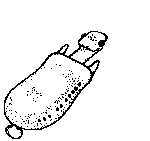

from: http://taxonomy.zoology.gla.ac.uk/~rdmp1c/teaching/L4/Evolution/Session2/cam.html
Phylogeny and Cladistics
I. Introduction
phylogenetic systematics
cladistics
II.. Elements of Cladistics
A. Introduction
-a cladogram is a testable hypothesis about the evolutionary relationships between organisms
-a complete clade is monophyletic
B. How do you construct a cladogram?
1. Identify a group of related organisms
-gather data on many aspects of phenotype
-species must vary in character states, present in some and absent in others
-hypothesize if characters are ancestral or derived
-without fossils, comparison is with a related out-group
-try to sort homology from analogy (if possible)
-analogy
the rules about homology
2. Construct a character table
3. Construct a cladogram
-all extant taxa are organized at the top of the cladogram
-all cladogram nodes must have a list of shared derived characteristics (synapomorphies) common to taxa above the node (a synapomorphy should only appears on a cladogram once)
- species that share synapomorphies belong to a clade
-each node represents a hypothetical ancestral species
-organisms in the same clade are assumed to be closely related because they share a common ancestor
-species that occur next to each other at the top of the cladogram are not necessarily closely related
C. What does the cladogram mean?
1. It is a hypothesis about the evolutionary history of an organism
-molecular data (protein, DNA sequences)
2. chronology implied by cladogram is relative, not absolute
3. cladograms are used to place species in a taxonomic hierarchy
4. Cladistics may replace Linnaean classification (phylocode)